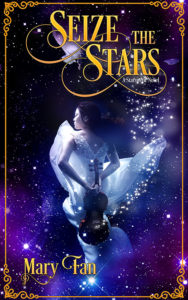A guest post by Mary Fan
Everyone has their own strategies, tricks, and systems for getting a story written. Me, I’ve always started out with some kind of outline, mostly because blank pages terrify me and I like knowing where my story is going. And also because I often come up with story ideas out of order—endings before beginnings, scenes I really want to happen even though I don’t know what will lead to them.
For this reason, I’ve always started off with a brainstorm—literally just opening up a Word doc and spilling ideas every which way. Because these days I’m often committed to various projects, I’ll also use these brainstorming docs to dump ideas that come to me for one story when I’m working on another. I’ve tried (in vain) to keep these ideas in some kind of order, but they always end up a jumbled mess (but in bullet points).
When it came time to finally settle down and write a book or short story, I used to start by creating a doc literally titled “What Happens—In Order.” And then I’d copy and paste bullet points (some of which were more like paragraphs with dots than anything resembling what a bulleted note should look like) in an order that made some kind of sense and fill in any gaps in the story. From there, I’d break it up into chapters.
That worked well for the first several novels I put out in the world. Each time, I had a clear sense of what was happening when before I started writing. But lately, that hasn’t been working so well. Maybe it’s because I started working with editors who would sometimes suggest rearranging, cutting, or adding entire chapters, and I realized just how malleable a story could be. Or maybe I just evolved as a writer.
 It was around when I started writing Wayward Stars (the second book of the Starswept trilogy) a few years back that I first discovered that my writing method had changed. I had the first half all nicely plotted, but I couldn’t for the life of me figure out what was supposed to happen in the second half. So I made it up as I went along—a first for me. Then, I when I sat down to write the third and final book of the series, Seize the Stars, I found myself completely at a loss when it came to my old method. I kept changing my mind about what order things should go in, coming up with new things that I didn’t know what to do with, changing my mind about whether I wanted certain events to happen. And all that copying and pasting of bullet points was getting really annoying (and messy).
It was around when I started writing Wayward Stars (the second book of the Starswept trilogy) a few years back that I first discovered that my writing method had changed. I had the first half all nicely plotted, but I couldn’t for the life of me figure out what was supposed to happen in the second half. So I made it up as I went along—a first for me. Then, I when I sat down to write the third and final book of the series, Seize the Stars, I found myself completely at a loss when it came to my old method. I kept changing my mind about what order things should go in, coming up with new things that I didn’t know what to do with, changing my mind about whether I wanted certain events to happen. And all that copying and pasting of bullet points was getting really annoying (and messy).
So I tried something different: the good old-fashioned notecard. Since I have Scrivener, I used the notecard function in that program, but it would have been easy to do on actual notecards too. Instead of having one document that said “Chapter 1 – this happens” and “Chapter 2 – that happens”, I jotted down individual scene ideas on (digital) notecards, then moved them around until they made sense. I even color coded them to keep track what day it was in the story world.
After I arranged everything into what felt like a nice order of events, I started writing. And then as I was writing, I would sometimes change my mind. A scene I thought would be a whole chapter was only a page long. A chapter I thought would be pretty short wanted to keep going. With the handy-dandy notecards, it became easy to insert new ones, split things up, and delete ones I decided I didn’t need after all. This also spared me the annoyance of having to copy and paste things from “Chapter 13” to “Chapter 16” or anything… I had no idea what any of my chapter numbers were until after the book was written.
Since then, I’ve used this method again on a few short stories and one more novel-length manuscript. It’s been working pretty well, so I think I’ll stick with it for a while. But who knows, after a few more, I might try something else entirely.
The Starswept Trilogy is available now!
About the Author
 Mary Fan is a sci-fi/fantasy writer hailing from New Jersey. She has a B.A. in Music (specializing in composition) from Princeton University. When she doesn’t have her nose buried in either a book or a laptop, she can usually be found at the opera house, the beer garden, or on an airplane heading anywhere. Learn more about Mary on her website.
Mary Fan is a sci-fi/fantasy writer hailing from New Jersey. She has a B.A. in Music (specializing in composition) from Princeton University. When she doesn’t have her nose buried in either a book or a laptop, she can usually be found at the opera house, the beer garden, or on an airplane heading anywhere. Learn more about Mary on her website.

Leave a Reply